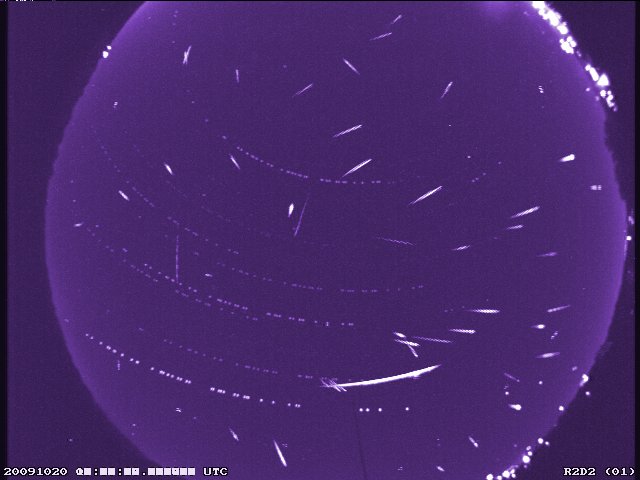Orionid Meteor Shower Peaks October 21–23, 2025
Best viewing under moonless skies from 1 a.m. to dawn
Each October, Earth passes through the inbound debris stream of Halley’s Comet, producing the annual Orionid Meteor Shower. The outbound portion of this same debris trail brings us the Eta Aquariid shower each spring.
Orionid activity begins in early October, but it’s not until mid-month that Earth encounters the densest part of the stream. The shower is typically of medium strength, producing 15–20 meteors per hour at maximum under dark skies. On rare occasions, rates have tripled — though such enhanced activity is not expected this year. Still, as always, only careful observation will reveal what 2025 has in store.
This illustration of debris from Halley’s Comet orbiting the sun is provided by Dr. Peter Jenniskens, SETI Institute/NASA/Ames Research Center.
.
When and Where to Watch
.
This year, the maximum is predicted for the mornings of October 21–23. From dark rural locations, observers could see up to 20 swift Orionid meteors per hour.
Orionid meteors don’t appear until after 10:00 p.m. local summer time, when their radiant — the point in the sky from which they appear to originate — rises above the eastern horizon. The best viewing comes between 1:00 a.m. and dawn, when the radiant climbs higher than 30° above the horizon.
This year the maximum activity is predicted to occur on the mornings of October 21-23 when up to 20 swift Orionid meteors could be visible per hour from rural locations away from city lights. Orionid meteors are not visible until after 22:00 (10pm) local daylight saving time as the source of these meteors does not rise above the eastern horizon until then. The best time to see these meteors is from 01:00 to dawn, when the Orionid radiant lies in excess of 30 degrees above the horizon.

Ideal Conditions in 2025
.
Viewing conditions will be excellent this year. The new moon on October 21 ensures dark skies with no lunar interference during the early morning hours. The only obstacles will be cloud cover and city lights. If skies are cloudy, check again on following mornings — Orionid activity remains strong for nearly a week centered on October 22.
For the best experience, find a safe, dark location away from city lights. The darker your surroundings, the more meteors you’ll see.
.
How to Watch
.
Lie back in a comfortable reclining chair, facing roughly south to take in a wide portion of the sky. Looking about halfway up from the horizon gives the best view, since more meteors are seen in this part of the sky than directly overhead.
Besides the Orionids, you might notice a few slower Taurid meteors, or swift ones from Gemini and Leo Minor — each contributing only a couple of meteors per hour. Random “sporadic” meteors, unrelated to any specific shower, typically number around 10 per hour at this time of year.
Observers in the Southern Hemisphere can also enjoy the Orionids, though the radiant appears lower in their northern sky.

Become a Citizen Scientist
.
Watching meteor activity isn’t just fun — it’s also a way to contribute to real scientific research. By observing for at least an hour, recording each meteor’s shower association, and noting the faintest star visible in your sky, you can produce valuable scientific data.
For instructions, see the International Meteor Organization (IMO) guide to visual observations. Observers can share their data worldwide by using the IMO’s visual meteor report form — free for contributors and available to all registered users. Potential observers can also ask questions and list their observations to the AMS by commenting on this article.
.
Good Luck and Clear Skies!
.
With the moon out of the way and Halley’s ancient debris lighting up the skies, the 2025 Orionid Meteor Shower offers one of the best observing opportunities of the year.
 American Meteor Society
American Meteor Society
I live in western West Virginia just off the Ohio river. Last night just after1am while trying to see the Orionids I was looking up into the northwest sky and saw a huge fast moving bright light streaking across the sky like nothing I have ever seen before. It was amazing! What could it possibly have been?i am 76 years old and it blew my mind. Beautiful! (Rural area, very dark sky, NO clouds)
I can’t wait to see the Orionid meteor shower this year! I’ve been looking forward to it for weeks. Any tips on the best viewing spots?
Hi there: today Oct. 21, 2025 I was driving along the Atlantic coastline at 3:15 pm in Gloucester, MA driving south on Rte. 127. I saw what looked to be a big snowball in the sky with a short, fat tail (no contrail) It was traveling fast high in the sky heading south across Massachusetts Bay in a south by ? direction. It would have flown right past Logan airport. Can someone tell me what this was. Thank you!
Looked bigger than a star.. it started off green .. in bainbridge ohio at about 6 06 am ish
I saw that fireball last night over lake Tahoe it came from the east towards the west it was glowing green and so bright at dusk around 6 pm it was the coolest thing I ve ever seen it stayed burning till it got close to the lake the best one I ve ever seen